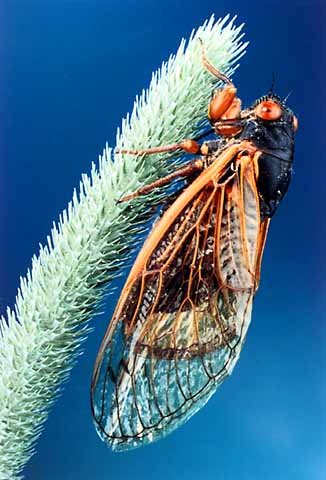tags: cicada, 17-year cicada, Magicicada
After seventeen years underground, immature cicadas are now emerging as full-fledged adults, ready to breed. Adult cicadas live, feed, and breed above ground for approximately two to six weeks before they die. The dark-colored insects are between one and two inches long with transparent veined wings, prominent red eyes and undeniable acoustic talents: the males produce a tremendously loud courtship song that sounds like a combination of a whirring blender and a lawn mover. Basically, cicadas are the most efficient and loudest sound-producing insects in the world.
"I'd be out in the trees working, and have someone five feet from me. We couldn't talk to one another because you couldn't hear them," recalled Tom Tiddens, supervisor of plant healthcare for the Chicago Botanic Garden, of the 1990 cicada eruption.
The largest populations of 17-year cicadas are found throughout Illinois, Indiana, Iowa, Michigan and Wisconsin. Scientists predict as many as 1.5 million bugs per acre, particularly in wooded areas where the soil has remained relatively undisturbed over the years. Cicadas are popular food items with birds and other wildlife.
"The wildlife is going crazy. You see squirrels and raccoons and skunks digging in the dirt, feasting on the cicadas that haven't come out yet," Tiddens said.
Cicadas are classified in the taxonomic order Hemiptera, in the superfamily, Cicadoidea. There are approximately 2,500 species of cicada around the globe, and surprisingly considering their size, many remain unclassified. Cicadas are vegetarians; spending most of their lives as nymphs, burrowing underground and sucking sap from tree roots.
The 17-year cicadas include three species, Magicicada septendecim, Magicicada cassini, and Magicicada septendecula. They belong to the largest group, or brood, of periodical cicadas, sometimes known as "Brood XIII". A brood emerges somewhere nearly every year, and these broods sometimes overlap with others. But none of the emergences matches the size of Brood XIII. There are at least 12 broods of 17-year cicadas plus another three broods of 13-year cicadas. Adults emerge every 13 or 17 years to avoid predators. As a result, their overall population densities are very high and the risk of predation for any one individual is quite low.
Cicadas are not harmful to humans, nor are they considered to be pests. In fact, they are often considered good eating by many people around the world. The female is especially prized for eating as she is meatier and contains more fat. Cicadas have been eaten (or are still eaten) in Ancient Greece, China, Malaya, Burma, Australia, North and South America and the Congo.
And now, with this year's emergence of cicadas, some Midwesterners are joining with people in other parts of the world by planning bug-themed dinners as well. They are swapping recipes for cicada cookies and are discussing which wine would be best paired with the "el chirper" tacos (see NPR link below for recipe).
Newly emerged cicadas, known as tenerals, are best for eating because their outer shell has not yet hardened. Tenerals should be collected in the very early hours of the morning, just after they have emerged but before they can climb out reach. The best way to collect is to go outside with a brown paper bag and start scooping them in. Tenerals can be cooked immediately, refrigerated until later (they remain alive but will mature much more slowly in the cold) or frozen until you cook them. Freezing works best for those you will roast since freezing changes the consistency of the meat.
National Public Radio (recipes)
LA Times (quotes).


Interesting. But, I don't think I will try them for a snack food. :)
I'd have trouble with eating them from NYC streets, just worrying about toxin accumulation. On thee other hand, I'm about to move down to Charlottesville VA....
Growing up on Long Island, it seemed like every three years or so we'd have a spring plague of something -- cicadas, frogs, slugs, moss, etc.
I'll be looking for the cookbook on the shelves soon.